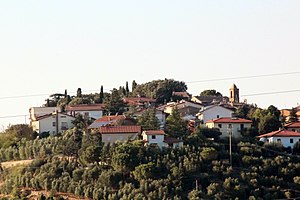Montenero d'Orcia
| Montenero d'Orcia | |||
|---|---|---|---|

|
|||
| Panorama of Montenero d'Orcia | |||
| Country | Italy | ||
| region | Tuscany | ||
| province | Grosseto (GR) | ||
| local community | Castel del Piano | ||
| Coordinates | 42 ° 57 ′ N , 11 ° 28 ′ E | ||
| height | 388 m slm | ||
| Residents | 243 (2011) | ||
| Telephone code | 0564 | CAP | 58033 |
Montenero d'Orcia is a district ( fraction , Italian frazione ) of the municipality of Castel del Piano in the province of Grosseto , Tuscany region in Italy .
geography
The place is about 8 kilometers northwest of the main town Castel del Piano and about 35 kilometers northeast of the provincial capital Grosseto in the Maremma and Orciatal ( Val d'Orcia ). The Orcia river , which flows approx. 1 km to the north, gives it its name. Approx. The Torrente Ente , a tributary of the Orcia, flows 11 km to the west . Montenero d'Orcia is located in the Archdiocese of Siena-Colle di Val d'Elsa-Montalcino and at 388 meters and had about 250 inhabitants in 2001. The closest places are Montegiovi (Castel del Piano), Porrona ( Cinigiano ) and Sant'Angelo in Colle ( Montalcino ).
history
The area of today's Montenero d'Orcia belonged from 903 to the monastery of San Salvatore di Monte Amiata . The castle (Castello, today Cassero) was first mentioned in 1015 and belonged in equal parts to the monastery of San Salvatore di Monte Amiata and the Aldobrandeschi . In the 13th century, the place was under the Visconti di Campiglia from Campiglia d'Orcia , who often came into conflict with the monastery of San Salvadore di Monte Amiata because of unpaid taxes. From 1375 the Salimbeni from Siena ruled the place, from 1400 Montenero d'Orica was directly under the government in Siena. After the defeat of the Republic of Siena in 1555 against Florence and four more years of resistance under the government of Siena in exile from Montalcino ( Repubblica di Siena riparata in Montalcino ), the site added on 2 September 1559 after peace of Cateau-Cambrésis in the Grand Duchy of Tuscany . After that, the place first belonged to Cinigiano and later became a district of Castel del Piano. Several sources point to Montenero d'Orcia as the birthplace of Pietro Andrea Mattioli , who is also mentioned as being born in Siena.
Attractions
- Chiesa di Santa Lucia , church within the ramparts. Originated in the 12th century and was mentioned in letters from Popes Clement III in 1188 and 1198 . and Innocent III. mentioned. First belonged to the monastery of San Salvatore di Monte Amiata and then to the Abbey of Sant'Antimo . Contains on the right altar the canvas painting Madonna del Rosario e Santi , which comes from or from the environment of Alessandro Casolani . The painting Madonna col Bambino e due Angeli attributed to Pellegrino di Mariano , which was below the Madonna, is now in the Museum of Montalcino .
- Chiesa della Madonna , 16th century church that was renovated in the 18th century. Contains the work Madonna col Bambino ei Santi Giovanni Battista e Lorenzo , probably by Bernardino Fungai .
- Fortification walls that date from the 10th century and were significantly reinforced by the Senese government in the early 15th century. Contains a double fortified gate ( Porta del Castello ) behind the apse of the Chiesa della Madonna and in front of the Church of Santa Lucia.
- Cassero Senese , ruined castle, of which the tower still exists today. Created in 1404 by the government in Siena over the remains of an earlier fortification.
- Pozzo mediceo , Piazza del Pozzo, 17th century fountain bearing the Medici coat of arms .
- Fortification walls that date from the 10th century and were significantly reinforced by the Senese government in the early 15th century. Contains a double fortified gate behind the apse of the Chiesa della Madonna, which still exists today.
traffic
- The place is near the street Strada provinciale 64 del Cipressino (SP 64), which connects Castel del Piano with the Strada Statale 223 di Paganico .
- The closest railway stop is the Stazione di Civitella Paganico station in Paganico (district of Civitella Paganico ). The stop is on the Siena – Grosseto railway line . The nearby station of Sant'Angelo Scalo near Sant'Angelo in Colle (municipality of Montalcino ) is no longer active and is only used irregularly by historic railroad cars.
photos
literature
- Giuseppe Guerrini / Amministrazione Provinciale di Grosseto: Torri e Castelli della provincia di Grosseto. Nuova Immagine Edizioni, Siena 1999, ISBN 88-7145-154-6 , p. 132.
- Felicia Rotundo / Bruno Santi: Casteldelpiano. In: Bruno Santi: Guida Storico-Artistica alla Maremma. Nuova Immagine Edizioni, Siena 1995, ISBN 88-7145-093-0 , p. 175 ff.
- Emanuele Repetti: MONTE NERO, o MONTENERO in Val d'Orcia. In: Dizionario Geografico Fisico Storico della Toscana (1833–1846). Online version of the University of Siena (pdf, Italian)
- Bruno Santi: I luoghi della Fede. L'Amiata e la Val d'Orcia. Arnoldo Mondadori Editore , Milan 1999, ISBN 88-04-46780-0 , p. 168.
Web links
Individual evidence
- ↑ a b c d Emanuele Repetti: MONTE NERO, o MONTENERO in Val d'Orcia.
- ↑ italia.indettaglio
- ↑ Official website of the ISTAT ( Istituto Nazionale di Statistica ) on the 2001 population figures in the province of Grosseto, accessed on August 24, 2016 (Italian)
- ↑ a b c Giuseppe Guerrini: Torri e Castelli della provincia di Grosseto.
- ↑ a b c d e f Mavarelli / Occhetti: Casteldelpiano.
- ↑ Cesare Preti: MATTIOLI (Matthioli), Pietro Andrea. In: Mario Caravale (ed.): Dizionario Biografico degli Italiani (DBI). Volume 72: Massimino-Mechetti. Istituto della Enciclopedia Italiana, Rome 2009.
- ↑ a b Bruno Santi (Ed.): I luoghi della Fede. L'Amiata e la Val d'Orcia.





